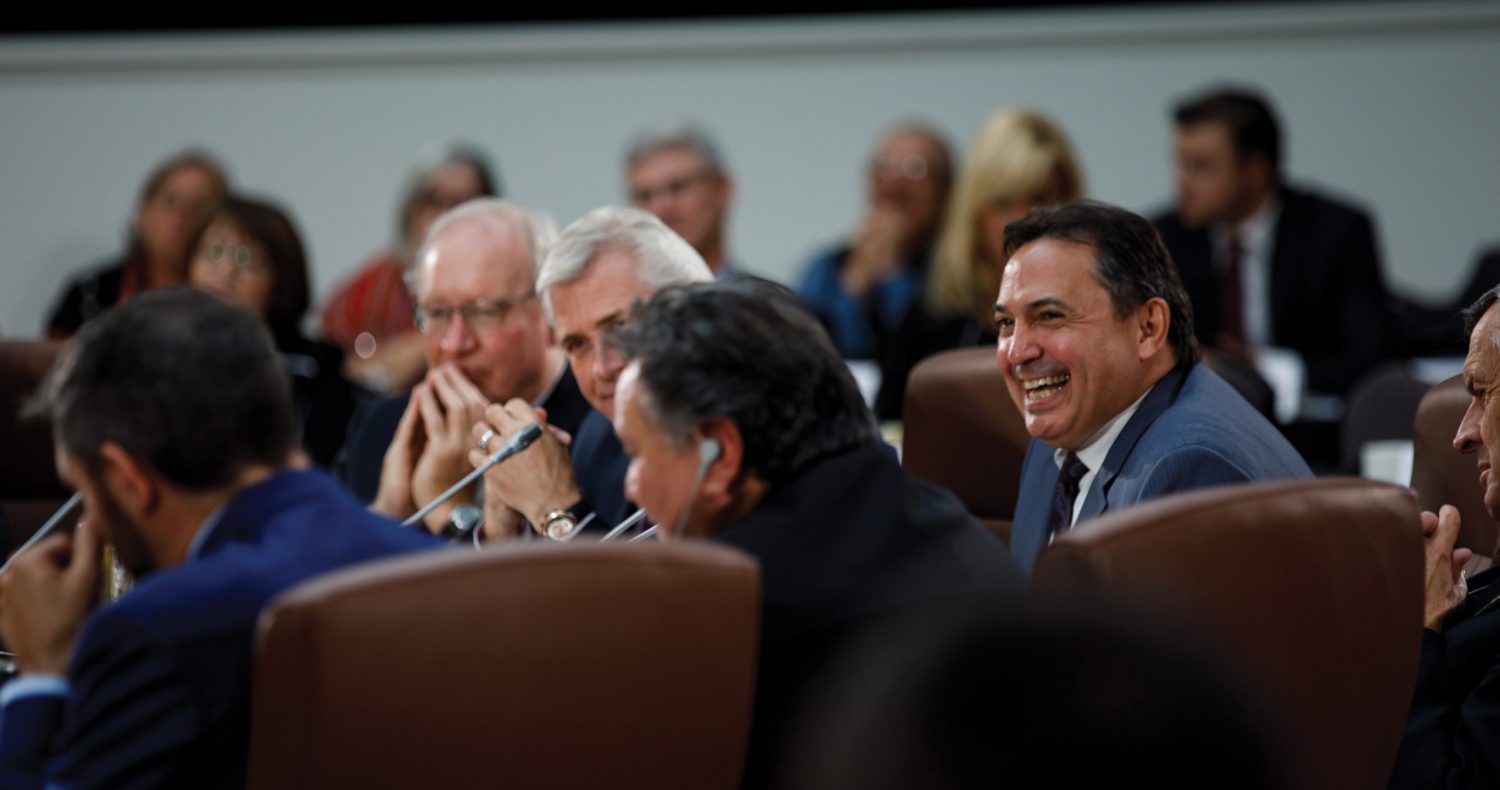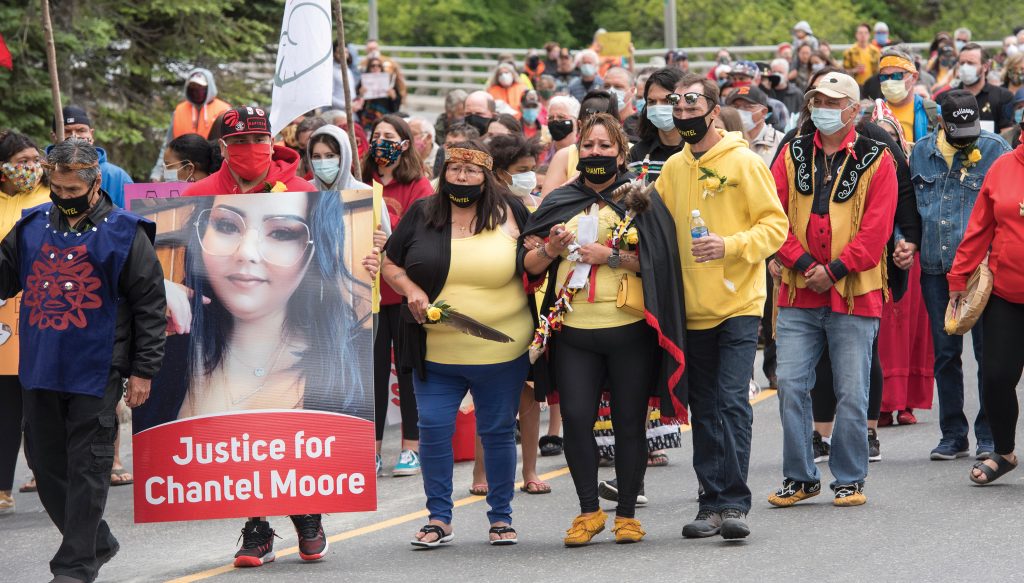First Nations Self-Policing: A Legacy of Success, and a Road to Healing

The principles and practices of First Nations self-policing are informed by spirituality, nature, history and, above all, relationality—the concept of being in “right relations” with those around you. At a time when conventional policing practices are producing especially alarming outcomes for Black and Indigenous people amid a worldwide outcry for reform, First Nations justice provides an alternative approach that works.
Perry Bellegarde
λáλíya̓ sila (Frank Brown), a hereditary chief of the Heiltsuk First Nation on the north coast of British Columbia, has made extraordinary contributions to the health and well-being of his people. But his life could have turned out very differently. At 14, λáλíya̓ sila was convicted of armed robbery and was about to be sent away to juvenile detention when his family requested that Heiltsuk law be followed instead. As a result, the young man was exiled to an island within Heiltsuk territory, to reflect on his crime, to learn his own traditions, and to heal. λáλíya̓ sila credits this intervention for turning his life around.
Frank Brown’s story has been on my mind lately. Recent high- profile incidents of police violence against First Nations women and men, and the catalyzing spark of Black Lives Matter, have focused long-overdue attention on the reality that First Nations continue to be both dangerously overpoliced and tragically under-protected. It’s clear that immediate action is needed to hold police accountable and to build and strengthen alternatives to respond to individuals in crisis. However, in this moment of reckoning, we must remember that First Nations have traditions of law and order—traditions that are able to generate healing rather than multiplying tragedy.
In June, 26-year-old Chantel Moore was killed by police in New Brunswick after reportedly brandishing a knife during a “wellness check” at her apartment in the middle of the night. A member of the Tla-o-qui-aht First Nation, a neighbour to the south of Frank Brown’s Heiltsuk Nation, she had recently moved to Edmunston to be closer to her mother and six-year old daughter. Not two weeks later, Rodney Levi, a member of the Metepenagiag First Nation, was shot and killed by an RCMP officer during an incident near Miramichi, N.B. A CTV News analysis published in June showed that an Indigenous person in Canada was more than 10 times more likely than a white person to have been shot and killed by a police officer since 2017.

These tragedies crystallize the urgent need for reform. At a time when public attention worldwide has been galvanized by the death of George Floyd and in Canada by these tragically violent encounters between police and First Nations individuals, the example of First Nations policing offers not only a path to reform but a best practices model, adaptable and scalable beyond our communities.
As University of Victoria Law Professor John Borrows and others have written, First Nations legal orders come from different sources than the more familiar laws of the Criminal Code, including spiritual teachings, traditional stories, and watching and learning from nature. Creator’s Law, Natural Law and First-Nations’ Law all work together to encourage people to live in harmony. Relationality is key. To be in “right relations” with those around you is the foundation of wellness and safety.
These laws and traditions are resilient. From the Dog Soldier societies that fiercely resisted colonial violence in the 1800s to the Bear Clan Patrol formed in the 1990’s to respond to a crisis of violence in Winnipeg’s inner city, there are numerous, dramatic examples of how we have upheld our laws and worked to keep our communities safe. There are also countless subtle and everyday ways in which conflicts are mediated and grievances healed through the guidance of our Elders.
Where these traditions continue to be practised, they may go unnoticed and unremarked precisely because they have been so effective at keeping the peace. What is noticed, instead, is the way that safety and wellness are jeopardized when these traditions break down. Much like clean water, when Indigenous justice systems are not maintained—or when they’ve been sabotaged or taken away—we’re suddenly confronted with the life-and-death consequences of their absence.
Today, First Nations communities and individuals are living through a crisis that is not of their making. Canada’s efforts to eradicate the cultures, languages, and laws that define First Nations have resulted in profound intergenerational trauma. They have also put many of our people, especially our youth, on a collision course with a foreign structure of law and order that rarely demonstrates meaningful understanding of our reality, real capacity to meet the needs of our people, or accountability to our communities.
Canadians need to appreciate that the history of policing in this country is part of a larger story of the violent denial of our inherent rights in support of colonialism, itself inherently racist. The Truth and Reconciliation Commission concluded that the residential school system, and myriad other colonial laws and policies, were part of a systematic effort to seize our lands and wipe out First Nations as distinct cultures and peoples. Police were used to overthrow Indigenous structures and traditions of law and order and, in their place, impose laws aimed at our destruction.
In fact, the Royal Canadian Mounted Police, was created explicitly for this purpose. Their history includes confining First Nations to reservations while forcibly removing our children to attend the residential schools. There’s good reason why my Carrier Sekani sisters and brothers in British Columbia know the RCMP in their own language not as “friends” or “relations” but as “those who take us away.”
Today, many First Nations women and men continue to learn through hard experience to mistrust and fear the police. The tragic reality is those incidents of police violence and abuse that come to public attention because they are caught on camera are just a small part of a much wider pattern that is all-too-familiar to every First Nations person in Canada.
In my life, I have had the good fortune to also experience another side of policing. I have three brothers who have served with distinction in the RCMP, each having received their long-term service medal. I have also known many officers, Indigenous and non-Indigenous, who are deeply knowledgeable and respectful of First Nations history and cultures and are, in turn, respected and admired in the communities they serve.
From my own experience, I have no doubt that there are a great many police officers out there who genuinely want to be part of the solution. The trouble is that the system itself works to prevent them becoming the kind of police officers they want to be and that our communities need and deserve.
Officers are routinely sent to our communities with limited prior knowledge of First Nations cultures and little or no experience working in a First Nations context. Indeed, a great many RCMP sent to more remote and isolated communities are fresh out of Depot with little or no prior hands-on experience of any kind.
They often live apart from our people in the equivalent of gated communities that only reinforce the gulf of misunderstanding and mistrust. Furthermore, these officers are inevitably moved on to other communities before they have the chance to develop the relationships on which trust and effective policing are built.
These problems are compounded by an increasingly militarized policing model that emphasizes capacity to exercise overwhelming force rather than the skills to de-escalate and resolve conflict peaceably. There is something wrong when grandmothers defending rights affirmed in the Constitution and international human rights law are confronted by police officers armed for military combat. There is also something profoundly and dangerously wrong when armed law enforcement officers are the only ones able to respond when our community members are in crisis and call out for help. Throughout the country, mental health services have been neglected for far too long and the situation is particularly concerning for First Nations. One consequence is that police are filling the gaps, even though they don’t have the training or expertise needed. And their very presence can be triggering for individuals in crisis, contributing to the tragic escalation of those encounters.
I don’t believe that the solution to this crisis is to simply transfer resources from policing to social services. In First Nations communities, policing is also underfunded and under-resourced, both in comparison to services provided to other communities and in comparison to our needs. Rather, what is needed is a different model of policing that is able to meet the real needs of First Nations, that is prepared to work in partnership with our communities, and that is adequately resourced to succeed.
Today, many First Nations administer their own police services, particularly in Quebec and Ontario. The benefits have been demonstrated time and again. Consider the Nishnawbe Aski Police Service in northern Ontario. In twenty-six years of policing 38,000 people in 34 communities they have never shot or killed anyone and never had an officer killed in the line of duty.
I have strongly advocated to Public Safety Minister Bill Blair that First Nations-controlled and administered police services be recognized as an essential service. In June, Minister Blair told the House of Commons that the federal government would work “to co-develop a legislative framework that recognizes First Nations policing as an essential service.”I am hopeful we will soon see new federal legislation on First Nations policing that will provide a foundation for significant investment in meeting the real needs of our communities.
It is also crucial that every officer receive human rights-based training that fosters cultural competency and promotes relationship building. Critically, the effectiveness of this training must be subject to independent review, including from the perspective of Indigenous peoples and racialized communities.
Today, many First Nations have developed their own orientation programs to ensure that officers entering their communities understand their history, protocols, and expectations. These programs, which help officers feel more at home and be more effective at their jobs, should be supported by all levels of government. It is also critical to dedicate more resources to community-based alternatives to calling in the police when individuals are in crisis. Funding models need to be flexible enough to ensure that each community can design the wrap-around services that they need and can develop multi-year program plans with the confidence that funding won’t suddenly run out. These measures and more are essential to addressing the immediate needs of First Nations. However, this is just the beginning.
Last year, the federal government adopted new child welfare legislation that responded to the strong desire of First Nations to exercise jurisdiction over family services according to our own laws and traditions. Implementation of the legislation will directly address one of the critical points of conflict between First Nations and the Canadian justice system, namely, child apprehension. More than that, the new legislation demonstrates that there is space within Canada to reconcile national laws and Indigenous legal orders.
So, I put to you a combined call to both action and justice, as numerous inquiries and inquests have done before. When Canada supports—tangibly and systemically—the revitalization and exercise of First Nations laws and legal orders, the crisis of First Nations policing, and indeed the crisis in the criminal justice system overall, will end. There are tangible steps already being taken and they must be built upon. There are also numerous policy proposals dating back decades yet to be meaningfully implemented.
When Canada chooses to be in right relations with First Nations it will be a better country and a beacon of justice and hope in a world that is grappling with how to achieve justice for all, not only the privileged few.
National Chief Perry Bellegarde has led the Assembly of First Nations, representing Canada’s 634 First Nations, since 2014. He is a proud member of the Little Black Bear First Nation in Treaty 4 Territory, Saskatchewan.
